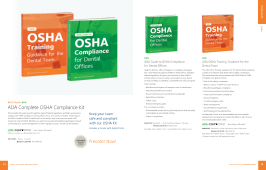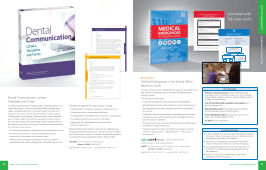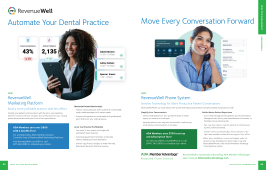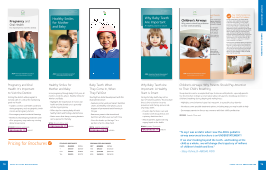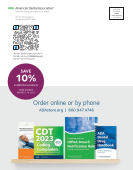How to Use Evidence-Based Dental Practices to Improve Your Clinical Decision-Making Developed by the ADA Center for Evidence-Based Dentistry, How to Use Evidence-Based Dental Practices to Improve Your Clinical Decision-Making is your definitive resource for: • Learning from leaders in the field of evidence-based dentistry (EBD) • Quickly conducting searches for the latest research • Mastering the art of critically appraising clinical studies • Confidently applying the latest research to treatment • Using clinical evidence in the classroom • Appreciate the role evidence plays in informing health policy • Better understanding the development of health technology assessments • Teaching others about practicing scientifically informed care J079BT Perfect bound + e-book, 299 pages | Members $69.95 Retail $104.95 Book ISBN: 978-1-68447-061-7 | e-book ISBN: 978-1-68447-062-4 “This book offers much to clinicians, both new learners and seasoned veterans, who wish to improve their skills in effective use of evidence in clinical practice. Beyond that, this book also offers insight into evidence translation, the meta skills needed to bring high-quality evidence into routine clinical practice, and ultimately into evidence informed health policy.” - Robert J. Weyant, D.M.D., Dr.PH., Pittsburgh, PA 42 © 2020 American Dental Association Box 3.1. Clinical Scenario You referred a patient to an oral and maxillofacial surgeon for surgical extraction of an impacted mandibular third molar that has been causing the patient to have repeated episodes of pericoronitis. Your patient returned from the surgery consultation session and told you that the surgeon explained the risk of a postoperative infection and how to avoid it. The surgeon gave your patient the option to use either chlorhexidine gel or chlorhexidine mouth rinse. Your patient now is asking for your opinion regarding which of these two options may be more effective. You are not sure, so you decide to search for evidence from a clinical study to answer this question. As described by the authors of Chapter 2 of this book, therapy questions can be stated using the population, intervention, comparison, outcomes (PICO) framework.4 The population is the patients who are to receive the intervention, the intervention is the treatment of interest, the comparison is the reference to which we are comparing the intervention, and the outcomes are the health consequences that depend on the intervention. The comparison can be a different treatment or no treatment at all. Table 3.1 shows two examples of therapy questions and their corresponding questions in the PICO framework: one of them has no treatment as the comparison and the other has an alternative treatment. Table 3.1. Examples of Therapy Questions and the PICO* Framework Clinical Question Population Intervention Comparison Outcomes Should I prescribe chlorhexidine gel or chlorhexidine mouth rinse to a patient undergoing third- molar extractions to avoid postoperative infection? Patients undergoing third-molar extractions Chlorhexidine gel Chlorhexidine mouth rinse Postoperative infections (alveolar osteitis, surgical site infection) Should I prescribe antibiotic prophylaxis for patients with diabetes undergoing endodontic treatment? Patients with diabetes who will receive endodontic treatment Antibiotic prophylaxis No treatment (that is, no administration of antibiotic prophylaxis) Postoperative infection, other postoperative complications What analgesic should I prescribe to my patients to manage pain after dental extractions? Patients undergoing dental extractions Ibuprofen Acetaminophen Postoperative pain * PICO = population, intervention, comparison, outcomes. How to Use Evidence-Based Dental Practices to Improve Your Clinical Decision-Making 11 Table 2.2. Main Examples of Clinical Questions, According to Their Natures Nature of the Question Intervention (Exposure or Diagnostic Test) Comparison (or Reference Standard) Therapy or Prevention What is the of antibiotics in preventing complications such as postoperative infections after third-molar extractions? Patients third-molar extractions Antibiotic prophylaxis No prophylaxis Alveolar osteitis, surgical wound infection Harm or Etiology Does giving toddlers milk instead of water to drink at night cause caries? Toddlers Drinking milk at night Drinking water at night Caries Diagnosis How useful is a periapical radiograph in detecting interproximal caries? Patients suspected of having interproximal caries Periapical radiograph Bitewing radiograph Diagnostic accuracy (as assessed by means of true-positive, true-negative, false-positive and false- negative findings) Prognosis Are patients with diabetes at higher risk of experiencing complications after third-molar extractions than are patients without diabetes? Patients undergoing third-molar extractions Presence of diabetes Absence of diabetes Pain, swelling, trismus, postoperative infections Source: Brignardello-Petersen R, Carrasco-Labra A, Booth HA, Glick M, Guyatt GH, Azarpazhooh A, Agoritsas T. “A practical approach to evidence-based dentistry: II: how to search for evidence to inform clinical decisions.” J Am Dent Assoc. 2014 Dec 145(12):1262-7. doi: 10.14219/jada.2014.113. PubMed PMID: 25429040. NEW Essentials of Dental Assisting, Seventh Edition Essentials of Dental Assisting, Seventh Edition, provides concise, easy-to-understand guidelines for the basic and expanded functions performed by dental assistants. • Expanded content features updated information in areas such as the electronic health record, preventive techniques, the impact of the Affordable Care Act, and cultural diversity • Updated photos and illustrations include vivid original renderings of head, neck, and dental anatomy, along with photos of the latest products, equipment, and instruments • Step-by-step procedures show techniques, the equipment and supplies needed, and the rationale behind each step, along with icons to identify the preparation and precautions • Multiple-choice review questions and Apply Your Knowledge questions are provided at the end of each chapter, allowing dental assistants and students to assess their comprehension and build problem-solving abilities P05022 Paperback book, 505 pages, 275 full-color photos and images Members $115.95 Retail $173.95 Book ISBN: 978-0-323-76402-5 From using the right instruments and techniques to understanding ACA and dental anatomy, this book covers it all. TABLE OF CONTENTS PART 1: THE PROFESSION 1 Introduction to Dental Assisting 2 Professional and Legal Aspects of Dental Assisting PART 2: THE SCIENCES 3 Anatomy and Physiology 4 Dental Anatomy PART 3: INFECTION CONTROL IN THE DENTAL SETTING 5 Microbiology and Disease Transmission 6 Management of Infection Control and Hazardous Materials 7 Surface Disinfection and Treatment Room Preparation 8 Instrument Processing PART 4: PATIENT CARE 9 The Dental Patient 10 Medical Emergencies in the Dental Office PART 5: FOUNDATION OF CLINICAL DENTISTRY 11 Delivering Dental Care 12 Instruments, Handpieces, and Accessories 13 The Dental Examination 14 Moisture Control 15 Pain and Anxiety Management PART 6: DENTAL IMAGING 16 Principles and Concepts of Radiation 17 Oral Radiography PART 7: DENTAL MATERIALS 18 Restorative and Esthetic Dental Materials 19 Impression Materials and Laboratory Procedures PART 8: PREVENTIVE DENTISTRY 20 Preventive Care 21 Coronal Polishing and Dental Sealants PART 9: COMPREHENSIVE DENTISTRY 22 Restorative Dentistry 23 Prosthodontics and Digital Technology 24 Periodontics 25 Endodontics 26 Oral and Maxillofacial Surgery 27 Pediatric Dentistry 28 Orthodontics PART 10: EMPLOYMENT 29 The Job Search Glossary ORDER BY PHONE: 800.947.4746 29 28 ORDER ONLINE: ADASTORE.ORG PRACTICE MANAGEMENT CLINICAL RESOURCES
Purchased by , From: ADA Ebooks (ebooks.ada.org)








